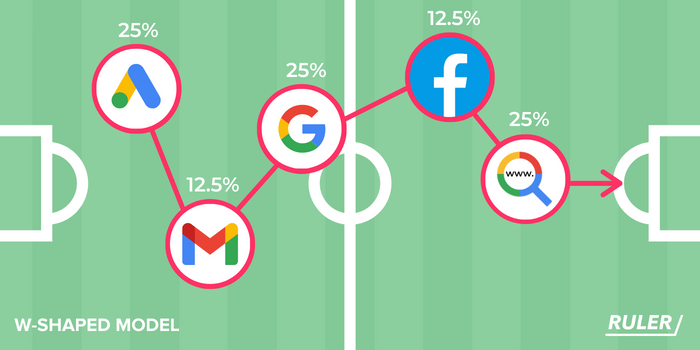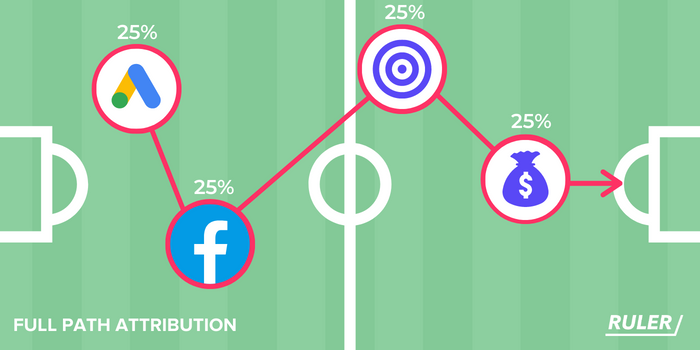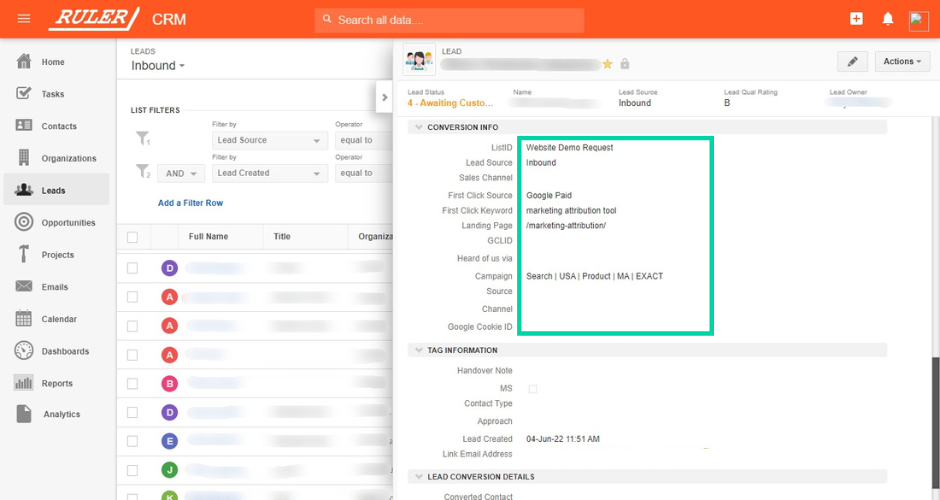Track which touchpoints generate the most value and how they relate to your overall marketing ROI with multi-channel attribution.
Multi-channel attribution is considered a must-have solution for marketers, but not many fully understand how it works.
Our data backs it up. More than half of respondents agree that a lack of skills and knowledge is the main barrier to successful marketing attribution.
We wanted to change that.
Whether you’re new to multi-channel attribution or would like a refresher on how to use it, this guide can offer a one-stop shop for information and top tips on how to get started.
For this article, we’ll discuss:
💡 Pro Tip
The launch of Apple’s iOS 14.5 update and Google’s third-party cookie phase out has made traditional multi-touch attribution less effective. Here at Ruler, we’re on a journey to combine multi-touch attribution and marketing mix modeling (MMM) to create a more effective approach to marketing measurement.
Book a demo and find out more
Multi-channel attribution is an analytical method that helps businesses understand the effectiveness of their marketing channels by tracking and assigning credit to every touchpoint along a customer’s journey.
Unlike single-touch attribution, which only credits conversions to the first or last touchpoint, multi-channel attribution aims to provide a more comprehensive and holistic view of the customer journey.
Multi-channel attribution starts by collecting data on all the touchpoints that a user interacts with before making a purchase or conversion. This includes email, display ads, social media, search ads, etc.
Once the data is collected, a multi-channel attribution model is applied to determine how credit should be assigned to each touchpoint.
There are various attribution models, including linear, time decay, and position-based models, each with their own rules for assigning credit (we’ll discuss these in more detail shortly).
After credit is assigned to each touchpoint, businesses can leverage the insights from multi-channel attribution to:
To recap, multi-channel attribution models are frameworks that accurately identify how and where your users engage with your marketing channels before completing a conversion or goal.
Related: What are marketing attribution models, and why are they important
There’s been an explosion of multi-touch attribution models in recent years, but we will briefly walk you through seven of most used models in digital marketing.

Linear attribution is a multi-touch attribution model that assigns equal credit to each touchpoint in a customer’s journey. In other words, every touchpoint is given an equal share of the credit for a conversion or sale.
It’s often used as a starting point for companies that are just beginning to implement multi-touch attribution.

In the example above, linear has divided all of the credit for the conversion equally across all of the touchpoints.
Linear attribution takes into account every touchpoint in a customer’s journey, giving you a more complete understanding of how users interact with your brand.
With time decay attribution, the credit for a conversion or sale is divided among all touchpoints, but the credit for each touchpoint decreases as the time between the touchpoint and the conversion increases.

In the example above, the time decay model has attributed the credit to all of the touchpoints but has given more credit to Facebook and organic search. The idea behind this model is that the closer a touchpoint is in time to the conversion, the more influential it is in the customer’s decision to convert.
For position based attribution assigns the majority of the credit for a conversion or sale to the first and last touchpoints in a customer’s journey, and splits the remaining credit among the middle touchpoints.

In the example above, position-based has allocated 40% credit to the Google ad and Facebook ad. The remaining touchpoints share the remaining 20% credit.
Position-based attribution is useful for companies that want to understand the impact of their branding and awareness campaigns (first touchpoint) and their conversion-focused campaigns (last touchpoint), as well as the impact of touchpoints that occur in between.
The W-shaped attribution model is a multi-touch attribution model that assigns credit for a conversion or sale to three key touchpoints in a customer’s journey: the first touchpoint, the middle touchpoints, and the last touchpoint.

In the example above, W-shaped attribution has allocated credit to the Google ad, Google search and Facebook. Like U-shaped attribution, the W-shaped model is best for companies who want to understand the role of their brand awareness and conversion-focused campaigns.
Full-path attribution is a multi-touch attribution model that assigns credit for a conversion or sale to all touchpoints in a customer’s journey, from the first interaction with a brand or product to the final conversion.
In this model, each touchpoint in the customer journey is given credit for the conversion, and the total credit for the conversion is equal to 100%.

In this case, 25% of the credit is given to four points:
Custom attribution is a type of attribution model that is designed and customised to fit the specific needs of a particular business or organisation.
Unlike other attribution models, which use predefined rules to allocate credit to different touchpoints, custom attribution models are tailored to the unique customer journey of each business.

In a custom attribution model, a business can define their own set of rules for allocating credit to different touchpoints based on their own understanding of their customer journey.
For example, a business may want to give more weight to touchpoints that occur on mobile devices, or they may want to give more weight to touchpoints that occur in specific geographic regions.
There’s no one-size-fits-all when it comes to multi-channel attribution, and each model has a series of pros and cons.
All of these attribution models will generate unique results, as they measure the importance of your touchpoints differently. The attribution model you choose will depend on the nature of the channels and campaigns you are tracking.
Multi channel attribution is a significant challenge for many businesses.
The data backs it up. Statistics show that only 45% of marketers in the US and UK are using multi-touch attribution to measure marketing effectiveness.
That’s less than half.
But why are marketers struggling with multi channel attribution? There are two main reasons.
💡 Pro Tip
These issues are a massive challenge for digital marketers, but there is a workaround. Keep reading on and learn how to overcome these common barriers.
Changes to privacy regulations and tracking technologies have had a significant impact on multi-channel attribution.
The cookie apocalypse and iOS 14.5 are mostly to blame.
In the wake of iOS 14.5, Apple users are now prompted to allow or deny tracking when they open an app for the first time and can change their settings at any time in the app’s privacy settings.
According to data gathered in March 2022, the overall ATT opt-in rate by iOS users worldwide was 46%.
This shift in data collection means businesses now have fewer data points available for analysis, and marketers have no choice but to attribute conversions and revenue based on incomplete and inaccurate data.
And let’s not forget about third-party cookies.
Third-party cookies have historically been an important factor for multi-touch attribution, as they allow advertisers to track users across multiple websites and devices.
However, third-party cookies are being phased out. Safari and Firefox have already taken the plunge to remove third-party cookie tracking, and Chrome has said it’ll block third-party cookies in 2024.
This has made it more difficult for marketers to track customer interactions across multiple channels and sessions and has inevitably made multi-channel attribution less reliable.
💡 Pro Tip
As third-party data becomes obsolete, many marketers are focusing on building up their first-party data. With first-party data, marketers can continue to track user interactions and attribute conversions across various marketing touchpoints.
All you need to know about third-party and first-party cookies
Multi-touch attribution was developed to measure the impact of your digital touchpoints, such as website visits, ad clicks, and conversions.
The word ‘digital’ is key here.
Digital attribution fails to take into account offline and invisible touchpoints, which also play a significant role in the customer journey (e.g. in-store visits, phone calls, TV and radio.)
Online interactions can be easily captured through website pixels, ad tracking, and other digital tools, which provide a clearer picture of how users interact with your website and brand.
But the same can’t be said for offline touchpoints.
These are significantly harder (often impossible) to pin down. For example, a user may see a TV ad and a few days later search on Google to make a purchase.
The online interaction can be tracked through cookies, pixels, and other digital tracking mechanisms. But there’s no way to link the search query to the TV ad using traditional multi-channel attribution.
To address this limitation, businesses have turned to alternative methods of measurement, such as brand lift studies and marketing mix modeling, to understand the impact of offline media on conversions and revenue.
We’ll dive into this in more detail shortly.
Multi-channel attribution is a must-have solution for many marketers, but without the right strategy and tools, it can get a little overwhelming. Below are three steps to help you get started with multi-channel attribution.
Aggregated data on your visitors is great for providing a general overview of traffic coming in and going out of your website.
But when your visitor data is aggregated, individual-level details are lost. This loss of granularity makes it difficult to identify specific touchpoints and opportunities along the customer journey.
To leverage the power of multi-channel attribution, you need to focus on capturing individual visitor data instead.
Related: A complete guide to website visitor tracking
Tracking visitors on an individual level allows you to monitor and measure the movements of specific visitors and gain a clear picture of their journey from start to close.
There are three ways you can collect individual data, which are often used in tandem.
1. JavaScript tracking. You need to collect data through JavaScript tracking. This involves adding a tracking code to your website so that you can capture data on your user’s interactions, such as clicks, page views, and other interactions.
2. UTM tracking. Adding UTM parameters to links can help you identify the source, medium, and campaign that drove the traffic to your site, which can be used to attribute credit to each touchpoint in the customer journey.
3. Third-party attribution tracking. Good attribution software allows you to map every touchpoint that a user engages with across multiple channels and campaigns. Take Ruler Analytics, for example. Ruler is a multi-channel attribution product that evidences every step a visitor makes in their journey and matches revenue back to your marketing.
The next step is to store your leads and marketing attribution data in a single location.
In our opinion, a CRM is the best option to store and manage your prospects, customers and marketing interactions.
A CRM provides a central location to store all your sales and marketing data.
Most CRMs come with customisable fields. You can use these fields to capture your lead’s interactions, marketing campaigns, and visitor data alongside your sales information.
Here we use Insightly to track and store sales data. We’ve integrated Insightly with Ruler to enrich our leads, opportunities and deals with attribution data.
Take the example below.

In this record, we can see that this lead converted after completing a PPC search and converted on our marketing attribution product page.
Without Ruler’s data, chances are our CRM would attribute leads to “Online” or “Web”.
But now, we can track the effectiveness of specific ads and campaigns at every stage of the funnel and spot opportunities and risks well ahead of time.
To make the most of multi-channel attribution data, it helps if you feed the data into other marketing tools.
Sharing marketing attribution data between tools helps reduce data silos and provides a unified view of marketing and sales performance.
This ensures that all teams are working from the same page and collaborating as much as possible.
For example, we feed multi-touch attribution and CRM data into Chartmogul.
If you’re not familiar with ChartMogul, it’s a cloud-based analytics platform that provides subscription and recurring revenue metrics for businesses.
Enriching our Chartmogul with attribution data allows us to track leads across the customer lifecycle and identify the amount of revenue each marketing-acquired lead generates over time.
In ChartMogul, we’ve set up custom fields, and marketing source data is passed from our attribution solution and CRM.
This allows us to:
While multi-channel attribution is a valuable tool for businesses that want to understand the impact of their marketing, it’s not perfect.
We’ve already discussed the struggles around iOS 14.5 and the death of third-party cookies.
But there are a few other limitations you need to be aware of:
Digital attribution tracks clicks: Attribution measures click path data. So offline touchpoints, dark social, and impressions are entirely ignored in most models.
Overestimates direct and organic channels. As attribution models mostly measure click path data, they often overvalue the impact of your direct and search channels.
Focus on the short term. Traditional attribution models aren’t built to track interactions beyond a few weeks. Research from Meta confirmed that ads affect users for years and months.
To overcome these challenges and the cookie and walled garden limitations, we’re using a mixture of multi-channel attribution and marketing mix modeling.
We still rely on multi-channel attribution to track click path data, short-term effects and bottom-of-the-funnel channels.
But we use marketing mix marketing to collect aggregate, long-term data, to understand the impact of our invisible touchpoints (e.g. ad views, TV and radio).
Here’s a snapshot of Ruler’s marketing mix modeling dashboard.

There core features that make it a powerful choice for marketing mix modeling.
Ruler’s MMM uses statistical modeling techniques to analyse the impact of your invisible touchpoints and interactions such as ad views, TV and radio.
Due to the way impression impact is calculated using diminishing return curves, Ruler can predict the point at which additional investments will no longer result in a significant return.
Then, it gives you recommendations on where you should be spending your budget for maximum results.
There’s more yet.
Since iOS 14.5, retargeting options on Facebook have been limited.
But with Ruler, you can send MQLs, opportunities, and closed revenue back to Google Ads and Meta as conversions for reporting and algorithmic optimisation purposes (e.g. smart bidding).
Book a demo of Ruler to see it in action for yourself here.
This rise of digital channels has made it increasingly difficult for marketers to measure the effectiveness of different marketing tactics.
Multi-channel attribution is a good place to start, but it only takes you so far.
When you leverage multi-touch attribution and MMM, you can get better visibility into which marketing channels and tactics drive the most impact on your bottom line.
And tools like Ruler make the process so easy.
If you’re ready to get started with marketing mix modeling, book a demo. Or read our blog on marketing mix modeling to learn more about the benefits.
